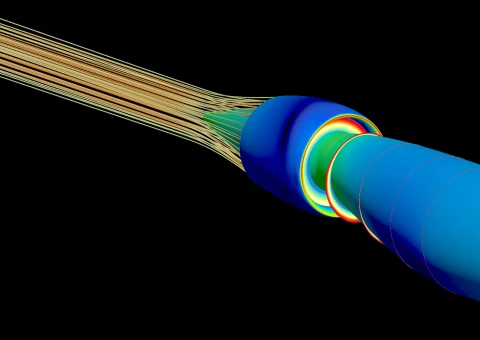
Background
The increasing awareness about the impact of civil air transportation emissions is currently driving a low-carbon technology transition, towards more sustainable propulsion strategies.
In this respect, a high level of engine-fuselage integration is expected: in fact, new generation propulsive systems cannot be simply retro-fitted into conventional aircraft architectures, but they require a full integration with the fuselage and new design paradigms generating disruptive configurations in order to fully exploit their potential in terms of increased efficiency.
To this purpose, the transition to a distributed propulsion approach appears as one of the most promising solutions and, in particular, Boundary Layer Ingestion (BLI) engines play a key role. As opposed to standard podded engines, BLI engines feature an embedded configuration, so that part of the low-momentum boundary layer flow around the fuselage is ingested by the engine, and the aircraft wake is re-energized. As such, the boundary layer momentum deficit caused by the fuselage drag is partially recovered and the jet over-velocities and wake mixing losses are reduced, which gives a benefit in terms of propulsion efficiency.
Recently, several aircraft concepts featuring BLI engines have been proposed. However, the design space of such configurations is still poorly understood, since many degrees of freedom are present. Moreover, a deeply interdisciplinary design is needed. In fact, the engine-fuselage integration inherent to the BLI philosophy requires a coupled analysis of propulsion system performance and vehicle aerodynamics. In addition, the challenge of propulsive fan ingesting a distorted flow must be faced, besides potential aerodynamic interferences with the aircraft tailplanes and complexity of installation due to the necessity of integrate engine nozzle into the fuselage rear end.
Existing studies have mainly concentrated on elementary concepts for preliminary BLI validation, i.e. axisymmetric fuselages without wings or rear empennages, as well as very elementary propulsor concepts with pre-assumed or specific boundary layer profiles. Similarly, experimental studies of aircraft concepts were also conducted, but they were limited to low speeds and focused on measurement of the power consumption and the boundary layer ingested, thus lacking an overall assessment of BLI impact at aircraft level. On the other hand, high-speed wind tunnel tests are limited to the boundary layer ingesting fan without including the aircraft.
In this context, a systematic experimental study on how the BLI technology is influenced by the aircraft architecture, and the subsequent definition of the best aircraft configuration to integrate BLI, is still missing.
Strategy
The SUBLIME project will answer some of the uncertainties in the area of BLI by performing an integrated investigation between several wing+fuselage configurations and BLI propulsor concepts. In particular, a more coupled evaluation of realistic installed propulsors aircraft configurations, tested up to transonic Mach numbers, will be performed, giving a significant step forward in the validation and understanding of BLI concepts.
On one hand, a number of BLI architectures, both of the 180 and 360 type, will be manufactured and tested in the ARA transonic wind tunnel, with the aim of assessing how propulsor inlet distortion, power saving and aircraft aerodynamics is influenced by the specific BLI configuration, the propulsor longitudinal position, the wing position and the flight conditions. Detailed flow characteristics and overall performance data will be extracted thanks to advanced measurement techniques, like Boundary Layer PIV and Pressure Sensitive Paint (PSP). Specifically, the amount of propulsive power saving which can be achieved thanks to the ingestion of body wake will be quantified.
On the other hand, the wind tunnel data will support high-fidelity CFD simulations to consistently predict full scale behaviour of the aircraft architectures suitable for appropriate propulsor installation which minimizes inlet flow distortion and maximizes power saving. To this purpose, advanced multi-objective optimization techniques embedded in the HIT09 optimization platform GeDEA-II, coupled with accurate thrust and drag bookkeeping methodologies, will be used to carry out the detailed optimized design of BLI aft fuselage and nacelle. In addition, a distortion-tolerant transonic fan will be designed to evaluate effect of BLI on fan performance and stability: actually, a reduction in fan total pressure ratio, efficiency and stall margin is expected as a result of the ingested boundary layer.
Finally, an assessment of BLI benefits at aircraft and mission level will be carried out and a comprehensive, combined experimental/numerical database for aircraft/propulsor BLI architectures built up, through which the most influential variables of aircraft architecture for BLI can be identified and their effect quantified.
Outcomes
The project is currently on going. So far, the following results have been achieved:
1. The BLI architectures and pertinent variants to be wind-tunnel tested have been selected;
2. The propulsor simulator to be used in the wind tunnel tests has been selected;
3. The measurement techniques to be used in the wind tunnel campaign have been defined.
4. The model-scaled BLI 360 and 180 concepts to be tested have been optimized;
5. The main wind tunnel model components have been designed and manufacturing initiated;
6. The thrust and drag bookkeeping methodology is being assessed.
7. A parametric engine deck model has been generated.
Wind tunnel tests of BLI architectures are planned in mid 2022.
Duration: December 2019-November 2022
This project has received funding from the Clean Sky 2 Joint Undertaking (JU) under grant agreement No. 864803









